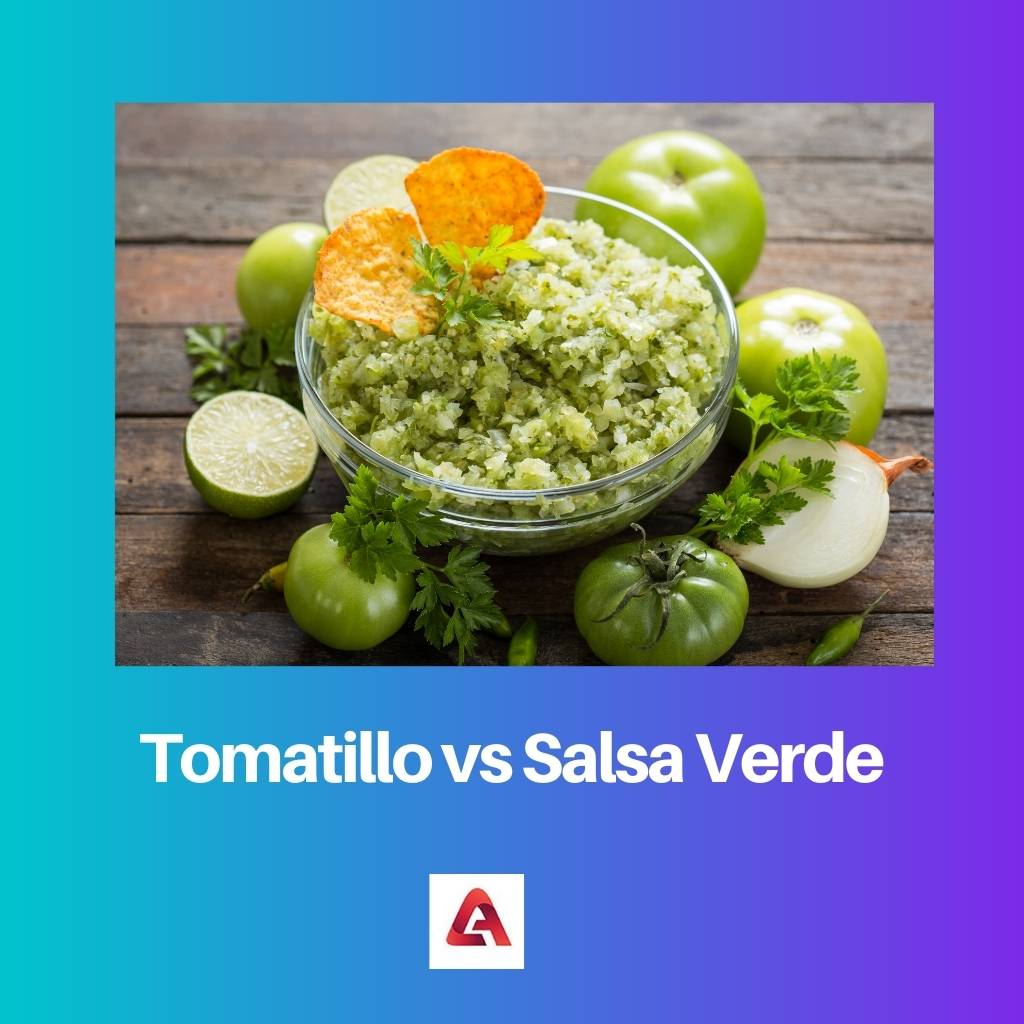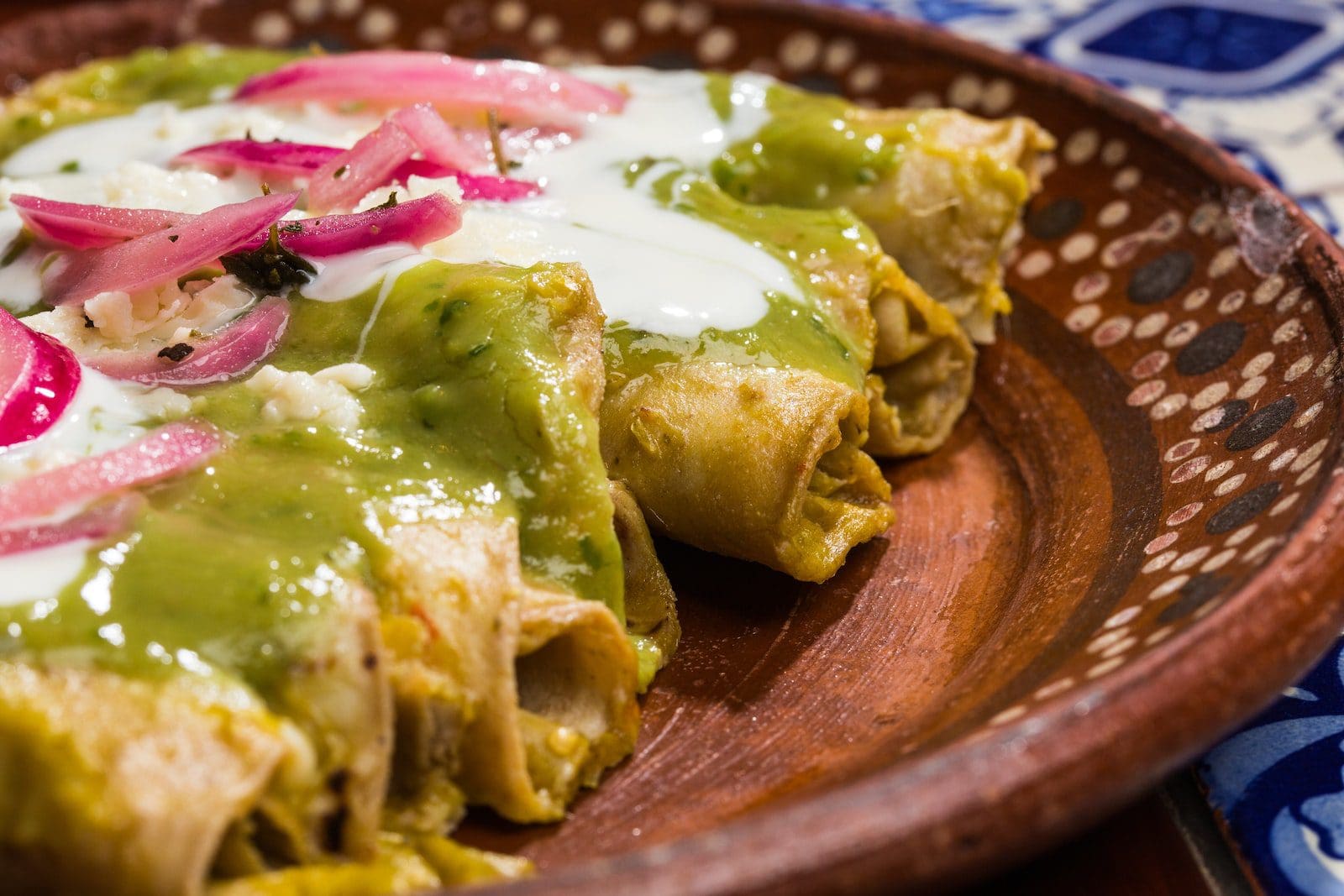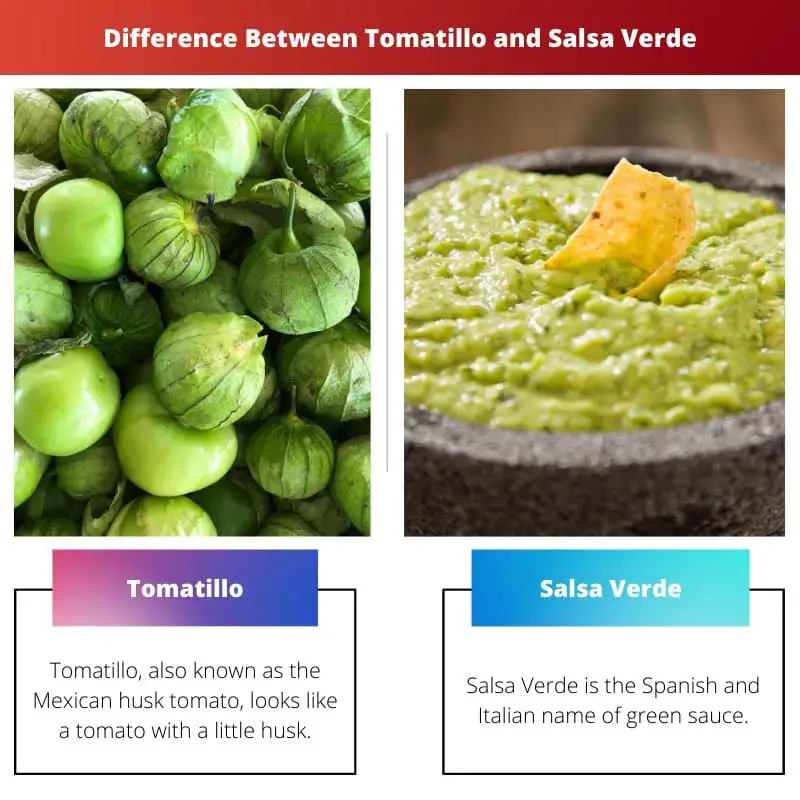In Mexican cuisine, most of the dishes are based on the type of sauces used and their stuffing. The dish salsa Verde is based made from the tomatillo.
Now, these tomatillos are small and green vegetables. In appearance, they look like tomatoes and actually do not belong to the tomatoes genus.
So in Mexico, a salsa Verde is a salsa based on tomatillo and is then mixed with several ingredients like onions and chilli peppers. Talking about the exact meaning of salsa Verde, it actually means green sauce in both the languages, Italian and Spanish.
Key Takeaways
- Tomatillos are a type of fruit with a papery husk that is removed before cooking.
- Salsa Verde is a green sauce made with tomatillos, chilli peppers, onion, and cilantro.
- Tomatillos can be used in various dishes, while Salsa Verde is specifically a sauce.
Tomatillo vs Salsa Verde
Tomatillos are green or yellow in color, covered by a papery husk that needs to be removed before use, have a slightly sour taste and are used in a variety of dishes. Salsa verde is a type of sauce made from tomatillos along with other ingredients such as chillies, onions, cilantro, and lime juice.

Tomatillo that is also known as the Mexican husk tomato, is a plant that looks like a tomato with a little husk but does not belong to the same family but is from the same nightshade family. Tomatillo bears small and spherical-shaped green or purple colored fruit having the same name.
Salsa verde is the Spanish and Italian name for green sauce. Basically, salsa verde is a family of half-cooked sauces that is made with herbs.
It actually comes under Mexican cuisine and is made with tomatillo. It is served with other Mexican dishes like enchiladas and chicharron.
Along with tomatillo, you need lime, jalapeno, chilli peppers, and onions.
Comparison Table
| Parameters of Comparison | Tomatillo | Salsa Verde |
|---|---|---|
| What are they? | Tomatillo, also known as the Mexican husk tomato, looks like a tomato with a little husk. | Salsa Verde is the Spanish and Italian name of green sauce. |
| Originated from | Mexico | Mexico |
| Main ingredients | Tomatillo itself is an ingredient and is used in several dishes. | The main ingredient used for making the salsa Verde sauce is the tomatillo. |
| Type | It is a type of tomato but with a little husk on it. It does not belong to the family of tomatoes but with the same nightshade family. | Salsa Verde is a type of green sauce used and eaten with many different dishes. |
| Uses | Tomatillo is used in many dishes as an ingredient. | Salsa Verde is a sauce that is eaten as a compliment with several dishes. |
What is Tomatillo?
Tomatillo that is also known as the Mexican husk tomato, is a plant that looks like a tomato with a little husk but does not belong to the same family but is from the same nightshade family. Tomatillo bears small and spherical-shaped green or purple colored fruit having the same name.
Tomatillos were used to cultivate in the Columbian era, but they originated from Mexico only.
Tomatillo is a staple or very common in Mexican cuisine. They are cooked with a variety of dishes and are eaten with many of them.
The main dish they are made with is salsa verde. Wild tomatillos are found everywhere in America and their related plants except for the far northern area, where there is the highest diversity in Mexico.
Before the coming of Europeans, tomatillos were domesticated in Mexico. After that, they played a major part in the culture of the Maya and Aztecs, even more important than tomatoes.

What is Salsa Verde?
Salsa verde is the Spanish and Italian name for green sauce. Basically, salsa verde is a family of half-cooked sauces that is made with herbs.
It actually comes under Mexican cuisine and is made with tomatillo. It is served with other Mexican dishes like enchiladas and chicharron.
Along with tomatillo, you need lime, jalapeno, chilli peppers, and onions.
There are many subtypes of this green sauce like- cooked sauce, in which several ingredients are cooked, and then they are grounded, other one is roasted salsa sauce, in which all the elements of the ingredients are roasted in the comal and are grounded, then there is raw in which all the ingredients are ground, and the sauce is prepared without even cooking, and the last one is a combination of everything where the ingredients are cooked properly.

Main Differences Between Tomatillo and Salsa Verde
- The main difference between tomatillo and salsa Verde is that Tomatillo, which is a Mexican husk tomato, is a plant that looks like a tomato with a little husk, while Salsa Verde is a Spanish and Italian name for green sauce.
- Tomatillo originated from Mexico, and salsa Verde also originated from Mexico.
- Tomatillo is an ingredient used in several dishes, while the main ingredient used for making the salsa Verde sauce is the tomatillo.
- Tomatillo is a type of tomato with a little husk on it. It does not belong to the family of tomatoes but with the same nightshade family of it, but Salsa Verde is a type of green sauce used and eaten with many different dishes.
- Tomatillo is used in many dishes as an ingredient, but Salsa Verde is a sauce that is eaten as a complement to several dishes.

- https://journals.ashs.org/hortsci/view/journals/hortsci/40/5/article-p1312.xml
- https://www.torrossa.com/gs/resourceProxy?an=3134960&publisher=FZ8857

The comparison of tomatillo and salsa verde in the form of a table makes it easy to distinguish between the two. It’s wonderful to gain insights into the intricacies of Mexican culinary ingredients.
I share the same sentiment, Duncan37. The detailed comparison of tomatillo and salsa verde is a great way to deepen our understanding of Mexican cuisine.
The historical background provided for tomatillos and salsa verde is enlightening. It’s interesting to see how these ingredients have been integral to Mexican culture for centuries.
I couldn’t agree more, Layla. Understanding the cultural context of these ingredients enhances our understanding of Mexican cuisine.
Absolutely, Robertson. The deep-rooted traditions associated with tomatillos and salsa verde are truly fascinating.
The detailed explanation of the differences between tomatillo and salsa verde is enlightening. It’s fascinating to explore the unique characteristics and culinary uses of these distinct ingredients.
I completely agree, Butler Jacob. Learning about the historical and cultural context of tomatillos and salsa verde enhances our appreciation for Mexican cuisine.
The comparison table outlining the differences between tomatillo and salsa verde is incredibly insightful. It’s great to gain a deeper understanding of the roles these ingredients play in Mexican gastronomy.
I couldn’t agree more, Edwards. Exploring the unique properties of tomatillos and salsa verde provides a valuable perspective on Mexican culinary traditions.
The information provided about tomatillos and salsa verde is thorough and informative. Learning about the origins and uses of these ingredients enhances our culinary knowledge.
I completely agree, Icook. It’s fascinating to delve into the unique characteristics of diverse ingredients used in various cuisines.
Well said, Icook. Exploring the differences between tomatillos and salsa verde is a valuable learning experience.
The detailed breakdown of the differences between tomatillo and salsa verde is incredibly informative. It’s enriching to learn about the roles these ingredients play in Mexican cuisine.
Well stated, Powell. Exploring the distinctions between tomatillo and salsa verde adds depth to our understanding of Mexican cuisine.
I share the same sentiment, Powell. The comparison of tomatillo and salsa verde provides valuable insights into the intricacies of Mexican culinary traditions.
The detailed explanation of tomatillo and salsa verde is enlightening. It’s fascinating to learn about the unique characteristics and uses of these ingredients in Mexican cooking.
I couldn’t agree more, Cbell. Understanding the nuances of ingredients like tomatillo and salsa verde adds depth to our culinary knowledge.
Thank you for the detailed explanation of the differences between tomatillo and salsa verde. It’s fascinating to learn about the origins and uses of these ingredients in Mexican cuisine.
I agree, Freddie! The history and cultural significance of tomatillos and salsa verde are truly interesting.
The comprehensive description of tomatillo and salsa verde is truly captivating. It’s wonderful to explore the distinct features and cultural significance of these ingredients in Mexican cuisine.
Absolutely, Dominic. The rich history and unique characteristics of tomatillos and salsa verde make them essential components of Mexican culinary traditions.
The comparison table is very helpful in understanding the distinctions between tomatillo and salsa verde. It’s great to learn about different culinary traditions.
Absolutely, Adrian. Exploring the unique characteristics of various ingredients enriches our appreciation for diverse cuisines.